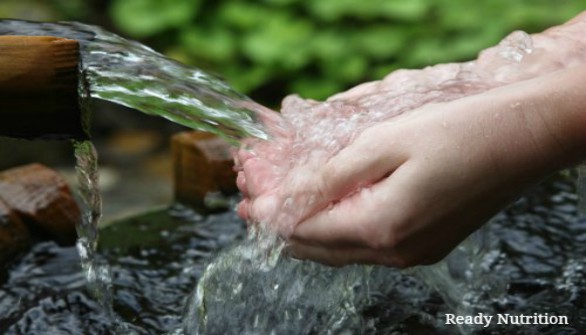One of the problems faced with an EMP (Electromagnetic Pulse) is that your well will not be pumping water into your home. For those living in urban areas and are relying on municipal water, your water could also be short-lived and it’s important to have a backup plan.
Well water is a different matter entirely because it is your well and you are responsible for getting the water. There are several solutions to this problem, and we’re going to close the article with a “quick fix” to enable you to get to the water. First, let’s cover Operational Security (or OPSEC) regarding your well.
Protect and Conceal Your Water
For starters, you’re not going to be the only one who is hungry or thirsty when it strikes. You need to camouflage, hide, or protect your well. A structure such as a small shed could come in handy in that regard, as well as providing a little bit of relief from the elements when you need to obtain the water. Cut a hole in the floor of the shed, and then drop it down on top of the well. Then it’s a simple matter to insulate the edges of where the ground and the hole meet with blow-in foam or such.
There are plenty of kits out on the market for you to be able to pump your own water out of the well by hand. Most of them have a special pneumatic part that will enable the suction to occur through PVC pipes that you join up. There are plenty of companies to offer such. Another way is to pick up a small generator (especially a quiet one, such as a Honda that features maintaining silence). Have a good electrician wire you up a connection on your electrical panel, so that you can just plug in the generator and run the pump.
If you pursue this option, ensure that the intake and the exhaust for your generator are sufficient to keep carbon monoxide and exhaust from going into the home. This is why the good electrician is worth his weight in gold. It will vary from state to state. In Montana, you can get away with just about everything, whereas in other states, you need to deal with permits, inspections, and even certifications to accomplish a simple task.
An Affordable Option For Getting Well Water
 Here is the last suggestion, the “affordable” one. Measure the inside diameter of your well, and take a reading to find how deep it runs. Next, you’ll need to cut a section of heavy PVC pipe and make it so there’s an inch on all sides when you place it into the well. Drill two holes in the top of it and attach a line to it running across on both sides and then connecting as a triangle to provide support…I prefer aluminum cable-wire on this one if you can get it. Next, run another stretch of aluminum wire through the center of your pipe-section.
Here is the last suggestion, the “affordable” one. Measure the inside diameter of your well, and take a reading to find how deep it runs. Next, you’ll need to cut a section of heavy PVC pipe and make it so there’s an inch on all sides when you place it into the well. Drill two holes in the top of it and attach a line to it running across on both sides and then connecting as a triangle to provide support…I prefer aluminum cable-wire on this one if you can get it. Next, run another stretch of aluminum wire through the center of your pipe-section.
The pipe should be cut to about 2 feet in length. A rubber ball that does not float is necessary for this one. The ball needs to completely cover one end of the pipe. Thread the second cable through the top part of the ball and secure it so that if you pull up on it, the ball will rest. You want the line to parallel the lifting line that you affixed to the top of the pipe.
You’ll lower the whole apparatus, and when the pipe fills with water, pull up the ball, “seating” it at the bottom, and then lift up the whole apparatus. The ball will hold the water in at the bottom of the pipe, and then you just drain off the water you pull up. I’m sure there are plenty of readers out there with good engineering experience, so your comments on improved design will be most welcome.



